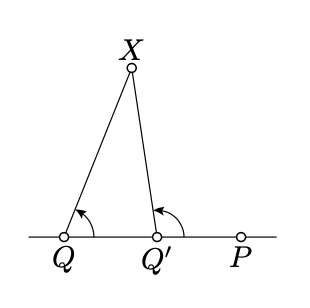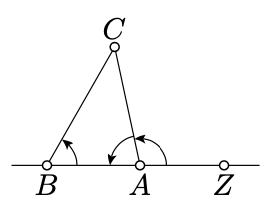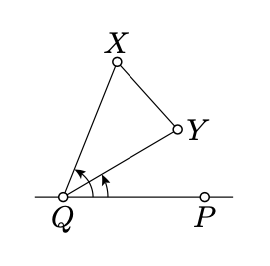3.3: Lemas del mismo signo
- Page ID
- 114419
Asumir\(Q' \in [PQ)\) y\(Q' \ne P\). Entonces para cualquiera\(X \in (PQ)\) los ángulos\(PQX\) y\(PQ'X\) tienen el mismo signo.

- Prueba
-
Por la Proposición 2.2.2, para cualquiera\(t \in [0, 1]\) hay un punto único\(Q_t \in [PQ)\) tal que
\[PQ_t = (1 - t) \cdot PQ + t \cdot PQ'.\]
Tenga en cuenta que el mapa\(t \mapsto Q_t\) es continuo,
\(Q_0 = Q\),\(Q_1 = Q'\)
y para cualquiera\(t \in [0, 1]\), tenemos eso\(P \ne Q_t\).
Aplicando Corolario 3.2.1\(P_t = P\), para\(Q_t\),\(X_t = X\), y, obtenemos que\(\angle PQX\) tiene el mismo signo que\(\angle PQ'X\).
En triángulo arbitrario no degenerado\(ABC\), los ángulos\(ABC, BCA,\) y\(CAB\) tienen el mismo signo.

- Prueba
-
Elige un punto\(Z \in (AB)\) para que\(A\) se encuentre entre\(B\) y\(Z\).
Según Lemma\(\PageIndex{1}\), los ángulos\(ZBC\) y\(ZAC\) tienen el mismo signo.
Tenga en cuenta que\(\measuredangle ABC = \measuredangle ZBC\) y
\[\measuredangle ZAC + \measuredangle CAB \equiv \pi.\]
Por lo tanto,\(\angle CAB\) tiene el mismo signo\(\angle ZAC\) que el que a su vez tiene el mismo signo que\(\measuredangle ABC = \measuredangle ZBC\).
Repetiendo el mismo argumento para\(\angle BCA\) y\(\angle CAB\), obtenemos el resultado.
Supongamos que\([XY]\) no se cruza\((PQ)\), entonces los ángulos\(PQX\) y\(PQY\) tienen el mismo signo.
La prueba es casi idéntica a la anterior.

- Prueba
-
De acuerdo con la Proposición 2.2.2, para cualquiera\(t \in [0, 1]\) hay un punto\(X_t \in [XY]\), tal que
\(XX_t = t \cdot XY.\)
Tenga en cuenta que el mapa\(t \mapsto X_t\) es continuo. Por otra parte\(X_0 = X\),\(X_1 = Y\),, y\(X_t \not\in (QP)\) para cualquier\(t \in [0, 1]\).
Aplicando Corolario 3.2.1\(P_t = P\), para\(Q_t = Q\),\(X_t\), y, obtenemos que\(\angle PQX\) tiene el mismo signo que\(\angle PQY\).


